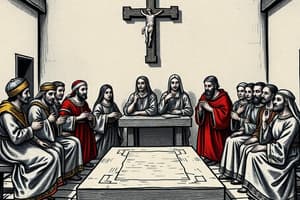Podcast
Questions and Answers
What was the outcome of the 2007 ruling by the Court regarding the arrest and torture of journalists?
What was the outcome of the 2007 ruling by the Court regarding the arrest and torture of journalists?
- There was insufficient evidence to prosecute. (correct)
- The perpetrators were prosecuted.
- The ruling favored stricter penalties.
- The case was dismissed without hearing.
In the events at San Salvador Atenco, which major violation was reported?
In the events at San Salvador Atenco, which major violation was reported?
- Political corruption.
- Economic fraud.
- Human rights violations and torture. (correct)
- Cybersecurity threats.
Who was the governor involved in the San Salvador Atenco events who later became president?
Who was the governor involved in the San Salvador Atenco events who later became president?
- Felipe Calderón.
- López Obrador.
- Margarita Zavala.
- Enrique Peña Nieto. (correct)
What significant event occurred in 2009 that resulted in widespread criticism but no accountability?
What significant event occurred in 2009 that resulted in widespread criticism but no accountability?
What issue did President López Obrador suggest about the SCJN in 2023?
What issue did President López Obrador suggest about the SCJN in 2023?
What was the response of the SCJN to President López Obrador's calls for reform?
What was the response of the SCJN to President López Obrador's calls for reform?
What connection was made between the ex-mayor José Luis N and a notable disappearance case?
What connection was made between the ex-mayor José Luis N and a notable disappearance case?
What did López Obrador call for to achieve a qualified majority for reforms?
What did López Obrador call for to achieve a qualified majority for reforms?
What was the main function of the Real Audiencia during the colonial period in Mexico City?
What was the main function of the Real Audiencia during the colonial period in Mexico City?
Which institution was established in Mexico following the Constitution of 1824?
Which institution was established in Mexico following the Constitution of 1824?
What significant change did the Constitution of 1857 bring regarding the judicial authority in Mexico?
What significant change did the Constitution of 1857 bring regarding the judicial authority in Mexico?
What event interrupted judicial functions in Mexico during the early 20th century?
What event interrupted judicial functions in Mexico during the early 20th century?
What was a key outcome of the constitutional reform proposed by Ernesto Zedillo in 1994?
What was a key outcome of the constitutional reform proposed by Ernesto Zedillo in 1994?
Which notable case led to criticism of the Supreme Court of Justice in Mexico?
Which notable case led to criticism of the Supreme Court of Justice in Mexico?
Which of the following issues has the Supreme Court of Justice NOT addressed since its restructuring?
Which of the following issues has the Supreme Court of Justice NOT addressed since its restructuring?
What was one of the motivations behind the constitutional reforms proposed by Ernesto Zedillo?
What was one of the motivations behind the constitutional reforms proposed by Ernesto Zedillo?
Study Notes
Colonial and Post-Independence Justice System
- Justice in colonial Mexico was administered by colonial courts, notably the Real Audiencia, which handled significant cases.
- After Mexico's independence, the judicial structure changed with the 1824 Constitution, establishing local and national judicial bodies, including the Supreme Court of Justice of the Nation (SCJN).
- The 1857 Constitution formally recognized the Tribunal Superior de Justicia as the highest judicial authority in Mexico City and the states.
Judicial Reforms and Constitutional Changes
- The Mexican Revolution disrupted judicial functions, but the 1917 Constitution reorganized the judicial system, maintaining local courts with significant authority in the capital.
- On December 5, 1994, President Ernesto Zedillo proposed a constitutional reform initiative focused on justice and public safety due to the lack of parliamentary majority for the PRI.
- The reform was negotiated with opposition parties and approved rapidly, promulgated on December 31, 1994, in the Official Journal of the Federation.
Supreme Court's Key Decisions
- The SCJN has issued rulings on socially significant issues, such as abortion rights, same-sex marriage, media regulation, recreational marijuana use, LGBTQ+ rights, and the tragic case of the ABC daycare fire.
Notable Criticisms Against the SCJN
- In the case of journalist Lydia Cacho, who faced arrest in 2005 for exposing child exploitation, the SCJN found insufficient evidence to prosecute those responsible for her torture and arrest, raising concerns about press freedom.
- The court also faced backlash for its handling of human rights violations during the San Salvador Atenco events, ruling against holding high-ranking officials accountable for abuses, including torture.
- The Supreme Court did not hold federal officials responsible for the 2009 ABC daycare fire, where 49 children died, a decision that sparked widespread societal outrage.
Contemporary Issues and Calls for Reform
- In 2023, President López Obrador suggested that the SCJN should undergo self-reform amid various controversies, including the release of dangerous criminals linked to high-profile cases.
- The case of José Luis N., an ex-mayor implicated in the Ayotzinapa student disappearance, highlighted perceived deficiencies in judicial accountability.
- The SCJN's president, Norma Piña, acknowledged the need for significant changes to promote justice in the country.
- President López Obrador encouraged public support for the "Plan C" to secure a legislative majority for constitutional reforms aimed at enhancing judicial effectiveness.
Studying That Suits You
Use AI to generate personalized quizzes and flashcards to suit your learning preferences.
Description
This quiz explores the historical evolution of the justice system in Mexico from the colonial era to the early post-independence period. It covers key institutions like the Real Audiencia and the establishment of the Supreme Court of Justice after the Constitution of 1824.




